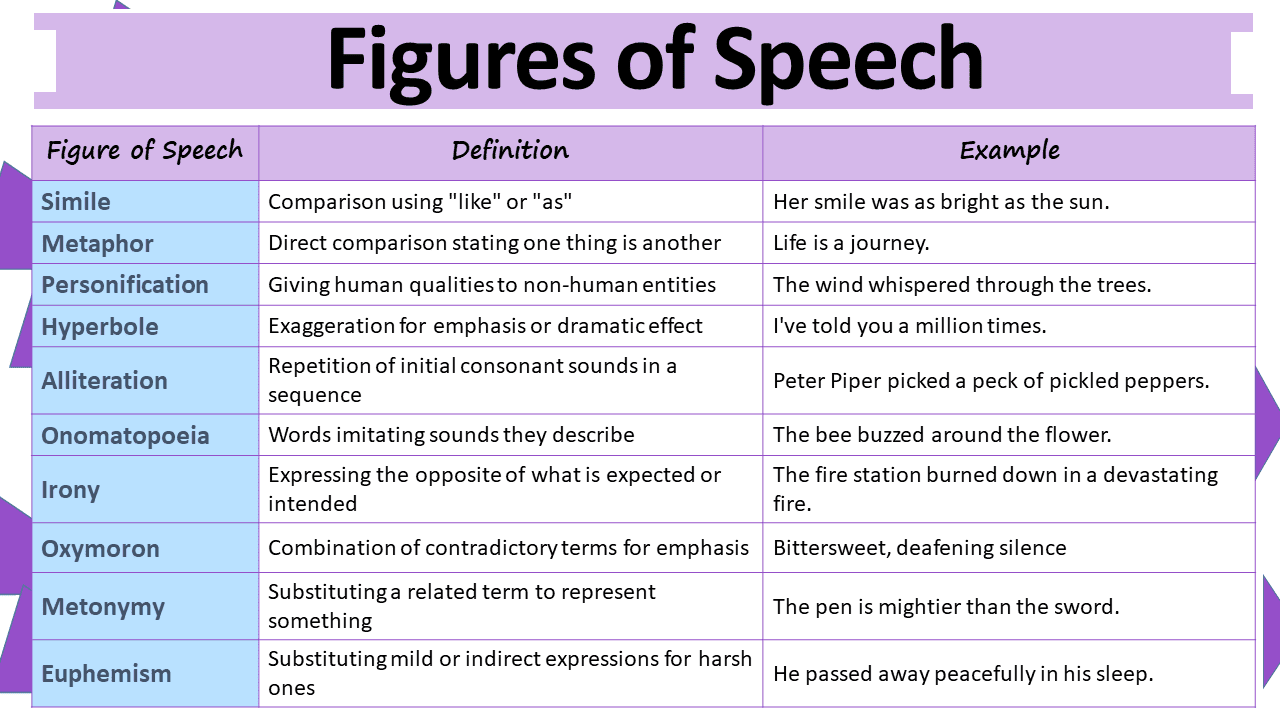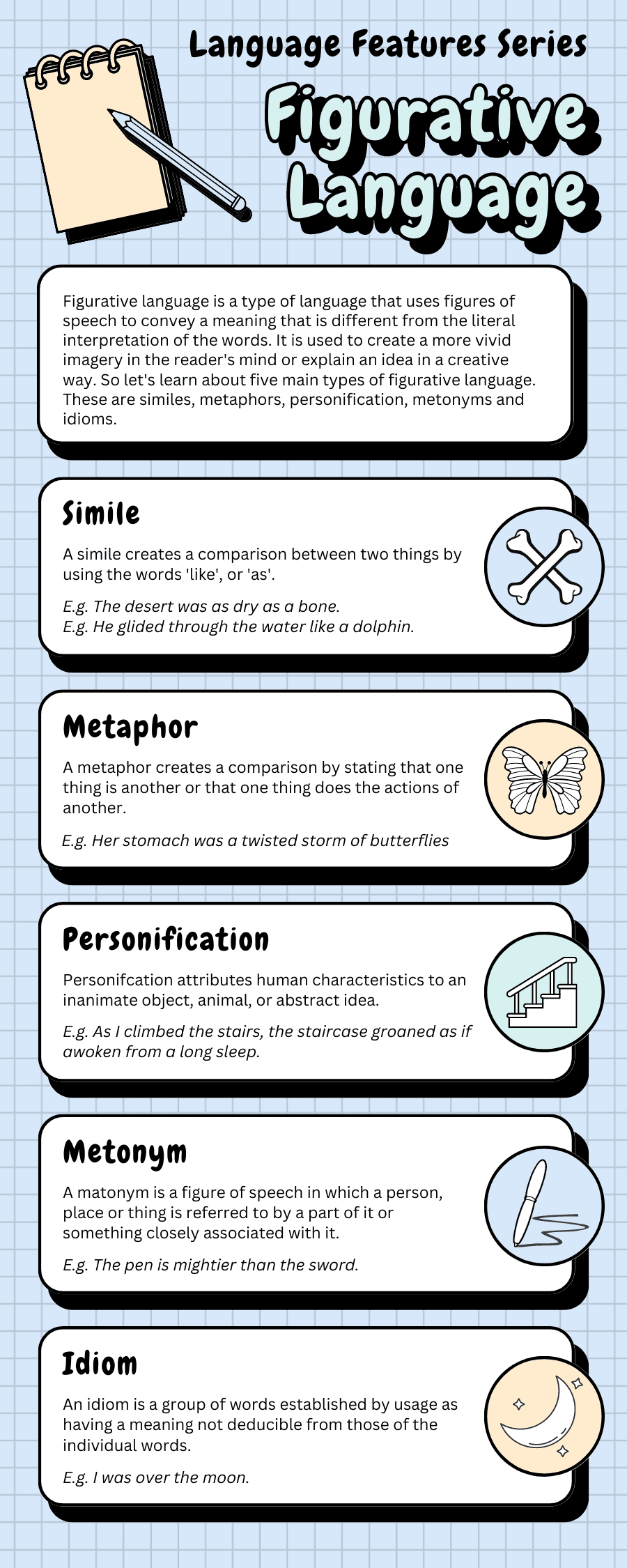In English, Figures of Speech are special ways to use words that make our writing more interesting. They help us say things in a creative way. For example, when we compare two things using ‘like’ or ‘as’, it’s called a simile. Metaphors are when we say something is something else, to make a strong picture in the reader’s mind. There’s also personification, where we talk about things like they’re people. And hyperbole, that’s when we really exaggerate to make a point. All these Figures of Speech make our writing more fun and help us express our ideas better.
30 Figures of Speech
- Simile: Similes are comparisons that use the words “like” or “as” to highlight similarities between two different things. They create vivid mental images and add a touch of poetic beauty to our expressions.
Example: Her laughter was as melodious as a chorus of songbirds. - Metaphor: Metaphors also make comparisons, but they do so by directly stating that one thing is another. Metaphors are powerful tools that help us convey complex ideas or emotions by associating them with more relatable concepts.
Example: Time is a relentless river, sweeping us along its currents. - Personification: Personification is a figure of speech in which human qualities are attributed to inanimate objects, animals, or abstract ideas. It breathes life into the inanimate and creates a deeper connection between the reader or listener and the subject. Example: The stars danced playfully in the night sky.
- Hyperbole: Hyperbole involves deliberate exaggeration for emphasis or dramatic effect. It is an excellent tool for adding humor, intensifying emotions, or making a point.
Example: I’ve told you a million times to clean your room! - Alliteration: Alliteration refers to the repetition of initial consonant sounds in a sequence of words. It adds a musical quality to language and enhances the rhythm and flow of a sentence.
Example: Peter Piper picked a peck of pickled peppers. - Onomatopoeia: Onomatopoeia is the use of words that imitate the sounds they describe. It creates a sensory experience for the reader or listener, bringing words to life. Example: The thunder roared and the rain pitter-pattered on the windowpane.
- Irony: Irony is a figure of speech that expresses the opposite of what is expected or intended. It adds a layer of complexity, surprise, or humor to our language.
Example: The fire station burned down in a devastating fire. - Oxymoron: An oxymoron combines two contradictory terms to create a new expression that often reveals a deeper truth or paradox. Example: Bittersweet, deafening silence filled the room.
- Metonymy: Metonymy is a figure of speech in which one word or phrase is substituted with another closely related term to represent it. It adds variety and depth to our language.
Example: The pen is mightier than the sword. - Synecdoche: Synecdoche is a figure of speech in which a part of something is used to represent the whole or vice versa. It allows for concise yet powerful expressions.
Example: All hands on deck! (Referring to the need for all people on the ship to help) - Assonance: Assonance is the repetition of vowel sounds within words that are close in proximity. It creates a musical quality and enhances the rhythm of a sentence.
Example: The rain in Spain falls mainly on the plain. - Euphemism: Euphemism involves the use of mild or indirect expressions to replace harsh or unpleasant words or phrases. It softens the impact of sensitive or taboo subjects.
Example: He passed away peacefully in his sleep. - Paradox: A paradox is a statement that appears contradictory but reveals a hidden truth or deeper meaning. It challenges our thinking and provokes reflection.
Example: Less is more. - Allusion: An allusion is a reference to a well-known person, place, event, or work of art, which adds depth and layers of meaning to a piece of writing.
Example: She had the Mona Lisa smile. - Apostrophe: Apostrophe is a figure of speech in which a speaker directly addresses an absent person, an inanimate object, or an abstract concept. It adds an element of directness and emotional intensity.
Example: O, Romeo, Romeo! Wherefore art thou Romeo? - Litotes: Litotes involves the use of understatement to express a positive statement by negating its opposite. It creates emphasis and often adds a touch of irony.
Example: The concert wasn’t bad; in fact, it was quite enjoyable. - Symbolism: Symbolism is the use of objects, actions, or ideas to represent deeper meanings or concepts. It adds layers of significance and invites interpretation.
Example: The dove is a symbol of peace. - Antithesis: Antithesis involves the juxtaposition of contrasting ideas or words within a sentence to create a striking contrast and highlight a point.
Example: It was the best of times; it was the worst of times. - Anaphora: Anaphora is the repetition of a word or phrase at the beginning of successive sentences or clauses. It adds emphasis, rhythm, and creates a memorable impact.
Example: We shall fight on the beaches, we shall fight on the landing grounds, we shall fight in the fields and in the streets. - Chiasmus: Chiasmus is a figure of speech in which the order of words or phrases is reversed in parallel clauses, creating a mirror-like structure. It adds balance and poetic elegance to a sentence.
Example: You can take the girl out of the country, but you can’t take the country out of the girl. - Synesthesia: Synesthesia is a figure of speech that blends different sensory experiences to evoke a vivid and unique perception. It combines unrelated senses to create a sensory crossover.
Example: The sweet sound of her laughter tasted like strawberries. - Hyperbaton: Hyperbaton is the deliberate rearrangement of words or phrases in a sentence for emphasis or stylistic effect. It disrupts the normal word order and draws attention to specific elements.
Example: Into the room walked a mysterious stranger. - Zeugma: Zeugma involves using a single word to modify or govern two or more other words in a sentence, often in a surprising or unexpected way. It creates a play on multiple meanings.
Example: She broke his heart and his favorite record. - Meiosis: Meiosis, also known as understatement or belittling, involves intentionally downplaying the significance or intensity of something for ironic or humorous effect.
Example: It’s just a flesh wound. - Polyptoton: Polyptoton is a figure of speech that involves repeating the same root word in different forms within a sentence or phrase. It adds emphasis and rhetorical flourish.
Example: I dreamed of running and becoming a great runner. - Paronomasia: Paronomasia, also known as pun, involves using words with similar sounds but different meanings to create a play on words. It adds humor, wit, or a clever twist.
Example: I used to be a baker, but I couldn’t make enough dough. - Epiphora: Epiphora, also called epistrophe, is the repetition of a word or phrase at the end of successive clauses or sentences. It creates a rhythmic pattern and reinforces a central idea.
Example: Love is patient, love is kind, love never fails. - Antanaclasis: Antanaclasis is a figure of speech that involves repeating a word or phrase while changing its meaning within the context. It adds cleverness and rhetorical impact.
Example: Time flies like an arrow; fruit flies like a banana. - Catachresis: Catachresis refers to the use of a strained or awkward metaphor or figure of speech. It creates an unexpected or jarring effect to emphasize a point or convey a unique perspective.
Example: I walked a long road of broken dreams. - Syllepsis: Syllepsis involves using a single word to modify two or more other words in different senses within a sentence. It creates ambiguity or surprise by applying the word in contrasting ways.
Example: She lost her keys and her temper.

